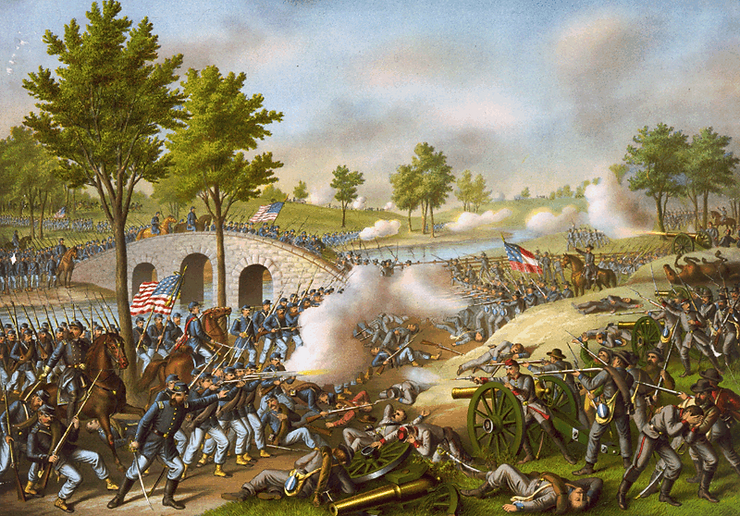By: Leo Chen
The Battle of Antietam was fought on September 17, 1862. It was the deadliest day in the American Civil War. The battle was fought at Antietam Creek, in northwestern Maryland. It was also called the Battle of Sharpsburg, a nearby town. You might be wondering, why is it the bloodiest battle recorded in the history of the American Civil War (1861-1865)? Well, after 12 hours of fighting, more than 23,000 men were already dead, wounded, or missing. This battle was a turning point in war after a Union victory, it was a great day for the Union and Abraham Lincoln.
When General Robert E. Lee met General McClellan, Lee divided his army into parts. He ordered about half of his troops with General Stonewall Jackson, who was at Harpers Ferry, Virginia, preparing for battle. At that time, the Union had captured Harpers Ferry and occupied it. As the Confederate was getting prepared, General McClellan replaced Officer John Pope as the commander of the Union army. McClellan took some of the 90,000 troops to meet Lee’s troops. The battle was starting to begin.
Soon, On September 15, Union forces at Harpers Ferry surrendered to Stonewall Jackson. Jackson left Harpers Ferry with his troops and joined Lee at Sharpsburg. Confederate General A. P. Hill stayed behind at Harpers Ferry to secure the surrender of the Union troops. On September 17, McClellan attacked Lee. But, because McClellan had waited to attack, Jackson’s troops were there to help Lee. McClellan ordered small, separate attacks. The Confederates moved troops from one part of the battlefield to another to meet these attacks. At 6 in the morning, Union General Joseph Hooker attacked the Confederates. He pushed toward Dunker Church at the northern end of the battlefield. But Stonewall Jackson stopped his push. Jackson also stopped two other Union attacks. In about five hours of fighting, these three attacks killed or wounded about 7,000 Union soldiers. About 5,000 Confederate soldiers were killed or wounded during the attacks. At about 10 in the bloody morning, south of Dunker Church, Union soldiers attacked the Confederates at Bloody Lane. After deadly fighting, the Union troops forced the Confederates out of the road. But there were not enough Union troops to go any farther, after the victory. McClellan chose to hold back. South of the Bloody Lane, Antietam Creek separated the Union and Confederate troops. Union General Ambrose E. Burnside concentrated his attacks on one stone bridge over Antietam creek. He attacked the bridge even though there were shallow places to cross nearby. Burnside’s tactics allowed a small Confederate force to delay a much larger Union force since there wasn’t much room for a whole army to cross. After about three hours, Burnside took control of the bridge and moved forward to the other side of the creek. Burnside spent another two hours reorganizing his force. Finally, he pushed
forward and closed in on Lee. Just as Burnside approached Lee, General Hill’s troops arrived from Harpers Ferry. They pushed Burnside back toward Antietam Creek. The Union advance stopped, and the battle ended. Even though Lee was heavily outnumbered after General Hill left, Lee and his army remained on the battlefield. The following day, McClellan chose not to continue the attack. Lee retreated to Virginia.
President Lincoln became unhappy with McClellan. Lincoln blamed his general for not pursuing Lee after Antietam. In November, Lincoln had General Burnside to replace McClellan.











